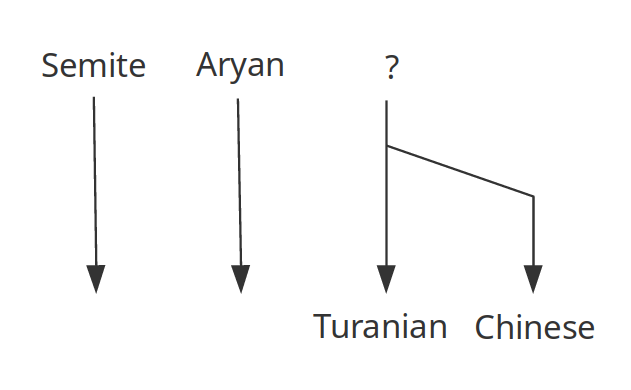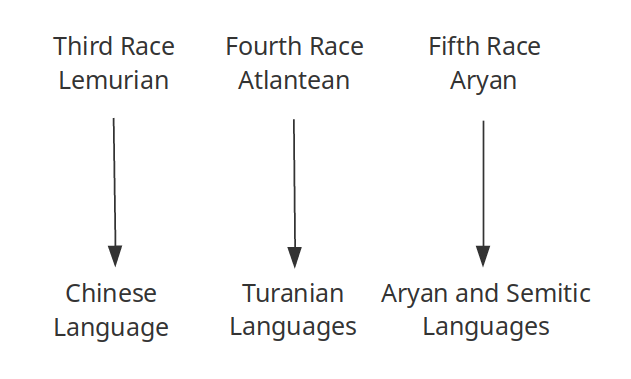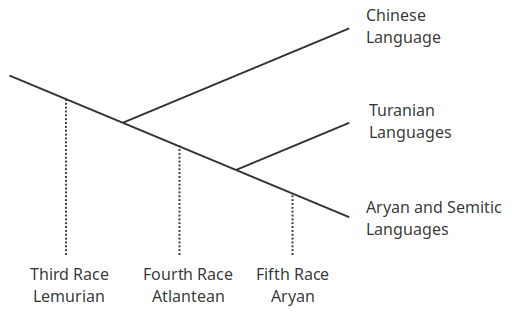Bhagavad-gītā, chapter 10, verse 6, referring to four preceding manus, was quoted in The Secret Doctrine (vol. 2, p. 140) in support of the Theosophical teaching of four preceding root-races. Since a manu is regarded as the progenitor of the humanity of its time period or manvantara, there is no difficulty in equating a manu with a root-race. The question is why the Bhagavad-gītā referred to the manus as four. This fits nicely with the Theosophical teaching, but not with the standard Hindu teaching. Indeed, because the standard Hindu teaching says that we are now in the seventh manvantara under the seventh manu, various Sanskrit commentators understood this line of the verse in varying ways. The Sanskrit line is ambiguous, allowing various interpretations. Does it really refer to the four preceding manus, thus supporting the Theosophical teaching of the four preceding root-races?
The translation of this verse quoted in The Secret Doctrine is that by T. Subba Row, from in his lecture on the Bhagavad-gītā given in December, 1886, and published in The Theosophist for April, 1887. Krishna is the speaker of this verse. It was there (vol. 8, p. 444) printed as:
“The seven great Rishis, the four preceding Manus, partaking of my nature, were born from my mind : from them sprang was (born) the human race and the world.”
This was slightly modified when H. P. Blavatsky quoted it in The Secret Doctrine (vol. 2, p. 140), legitimately making the singular “human race” into the plural “human races,” since the Sanskrit phrase, imāḥ prajāḥ, is plural:
“The Seven great Rishis, the four preceding Manus, partaking of my essence, were born from my mind : from them sprung (were born) the human races and the world.”
At that time there were very few translations of the Bhagavad-gītā available, the most prominent being the one by Kāshināth Trimbak Telang in the Sacred Books of the East Series, volume 8, 1882. Telang’s translation, pp. 86-87, similarly has “the four ancient Manus” for the words in question:
“The seven great sages, and likewise the four ancient Manus, whose descendants are (all) these people of the world, were all born from my mind, partaking of my powers.”
However, he adds a footnote to “the four ancient Manus”: “The words are also otherwise construed, ‘The four ancients (Sanaka, Sanandana, Sanātana, Sanatkumāra) and the Manus.’ According to later mythology the Manus are fourteen.”
That is, some commentators separate the “four ancients” from the manus, regarding the four ancients as the four kumāras (Sanaka, etc.), and the manus as a third group referred to in this line of the verse.
Subba Row was aware of this other interpretation, and he rejected it because of the well-known Hindu tradition that the kumāras refused to create, and thus humanity could not have sprung into existence from them. A long footnote quoting Subba Row’s comments on this verse is given in The Secret Doctrine. Immediately after this verse is quoted there in the main text, Blavatsky wrote: “Here the four preceding ‘Manus,’ out of the seven, are the four Races† which have already lived, since Krishna belongs to the Fifth Race, his death having inaugurated the Kali Yuga.” The footnote goes with “the four Races” (vol. 2, p. 140) [I have added the words in brackets]:
† This is corroborated by a learned Brahmin. In his most excellent lectures on the Bhagavad Gîtâ (see “Theosophist,” April, 1887, p. 444) the lecturer says: “There is a peculiarity to which I must call your attention. He (Krishna) speaks here of four Manus. Why does he speak of four? We are now in the seventh Manvantara, that of Vaivasvata. If he is speaking of the past Manus, he ought to speak of six, but he only mentions four. In some commentaries an attempt has been made to interpret this in a peculiar manner. The word ‘Chatvaraha’ [catvāraḥ, “four”] is separated from the word ‘Manavaha,’ [manavaḥ, manus] and is made to refer to Sanaka, Sanandana, Sanatkumâra, and Sanatsujata, who are also included among the mind-born sons of Prajâpati. But this interpretation will lead to a most absurd conclusion, and make the sentence contradict itself. The persons alluded to in the text have a qualifying clause in the sentence. It is well known that Sanaka and the other three refused to create, though the other sons had consented to do so; therefore, in speaking of those persons from whom humanity has sprung into existence, it would be absurd to include those four also in the list. The passage must be interpreted without splitting the compound into two nouns. The number of Manus will then be four, and the statement would then contradict the Purânic account, though it would be in harmony with the occult theory. You will recollect that it is stated (in Occultism) that we are now in the Fifth Root-Race. Each Root-Race is considered as the Santhathi [saṃtati, “race, progeny”] of a particular Manu. Now, the Fourth Race has passed, or, in other words, there have been four past Manus. . . . .”
What Subba Row says here about the meaning makes sense, and would well explain the unusual reference to four preceding manus, but the Sanskrit is not unambiguous. His statement saying that “The passage must be interpreted without splitting the compound into two nouns” is grammatically incorrect. The two words are not in a compound; they are individually declined: catvāro manavas. I have checked the text of the Bhagavad-gītā as found in the critical edition of the Mahābhārata published by the Bhandarkar Oriental Research Institute, and no variant reading is reported giving these two words in a compound. Since the words in this line of the verse are in the same nominative case, the same plural number, and the same masculine gender, any of them can be taken with any of them. The various Sanskrit commentators were fully aware of this, and they did so. The words of this line of the verse are:
maharṣayaḥ sapta pūrve catvāro manavas tathā, meaning the great rishis (maharṣayaḥ) seven (sapta) preceding or ancient (pūrve) four (catvāro) manus (manavas) also (tathā).
The “four” (catvāro) is in grammatical agreement with “preceding or ancient” (pūrve) and with “manus” (manavas). This allows the possibility of taking this phrase either as “the four preceding manus,” or as “the four ancients and also the manus.” Thus there could be two groups spoken of here in this line: the rishis and the manus; or there could be three groups spoken of here: the rishis, the ancients, and the manus. So how do we know what is meant?
For grammatically ambiguous passages such as this one, which are frequent in Sanskrit, the only available recourse we have is to commentaries. The older the commentary, the closer to the original in time, the more likely it is to represent the author’s intended meaning. However, the ancient commentaries on the Bhagavad-gītā are lost. The oldest available commentary is that by Śaṅkarācārya, perhaps a millennium or more after the Bhagavad-gītā was written. He sees two groups here: the seven rishis and the four manus. He glosses the word pūrve, “preceding or ancient,” simply as “belonging to past time,” atīta-kāla-saṃbandhinaḥ, without specifying whether it goes with the seven rishis or the four manus. Commentaries, too, can be ambiguous. Śaṅkara glosses the four manus as sāvarṇā iti prasiddhāḥ, “known as the sāvarṇas.” The next oldest available commentary is that by Rāmānuja. He, too, sees two groups here: the seven rishis and the four manus. Like Śaṅkara, he glosses the four manus as the sāvarṇas: sāvarṇikā nāma catvāro manavaḥ. So who are the sāvarṇas?
As is well known, fourteen manus are posited by Hinduism. These are, from earliest to latest: 1. Svāyambhuva; 2. Svārociṣa; 3. Uttama or Auttami; 4. Tāmasa; 5. Raivata; 6. Cākṣuṣa; 7. Vaivasvata; 8. Sāvarṇi or Sāvarṇo; 9. Dakṣa-sāvarṇi/o; 10. Brahma-sāvarṇi/o; 11. Dharma-sāvarṇi/o; 12. Rudra-sāvarṇi/o; 13. Raucya or Raucyadeva-sāvarṇi/o; 14. Bhautya or Indra-sāvarṇi/o. We are currently in the seventh manvantara, or time period of the seventh manu, Vaivasvata. As can be seen, the sāvarṇas are the future manus, Sāvarṇi/o, etc. Indeed, Rāmānuja’s sub-commentator Vedānta Deśika provides the names of the four sāvarṇikas: brahmasāvarṇo rudrasāvarṇo dharmasāvarṇo dakṣasāvarṇaḥ. This raises a problem. How can future manus be the progenitors from whom all the people of the world (loka imāḥ prajāḥ) have come, as the second half of the verse says?
The third oldest available commentary is that by Madhva. He, too, sees two groups here: the seven rishis and the four manus. But for him the four manus cannot be the sāvarṇas, and must be the first four manus, Svāyambhuva, etc.: catvāraḥ prathamāḥ svāyambhuvādyāḥ. Madhva’s sub-commentator Jayatīrtha provides the names of these four manus: Svāyambhuva, Svārociṣa, Raivata, and Uttama (svāyambhuva-svārociṣa-raivatottamāḥ). The later commentators Śaṅkarānanda and Rāghavendra agree, Śaṅkarānanda saying the same as Madhva: svāyambhuvādayaś catvāro manavaś ca, and Rāghavendra like Jayatīrtha adding the names of the four manus: Svāyambhuva, Svārociṣa, Raivata, and Uttama (catvāraḥ svāyambhuva-svārociṣa-raivatottamākhyāḥ manavaḥ). This interpretation, of course, leaves unanswered the question of why the Bhagavad-gītā refers to only four preceding manus rather than six manus preceding the seventh manvantara that we are now living in.
Other later commentators avoided this problem by seeing three groups here: the seven rishis, the four ancients, and the manus. Thus, Śrīdhara Svāmi (catvāro mahārṣayaḥ sanakādayaḥ), Upaniṣad Brahma Yogin (pūrve sanakādayo ’nye catvāraḥ), Keśava Kāśmīri Bhaṭṭācārya (catvāro mahārṣayaḥ sanakādayaḥ), Sadānanda (sanakādayaḥ), and Daivajña Paṇḍita Sūrya (catvāraḥ sanakādayas) all agree on seeing the four ancients as the four kumāras beginning with Sanaka, a separate group distinct from the manus. This, however, brings in its own problem, as pointed out by Subba Row: The kumāras are eternal youths, celibates, who did not create progeny; hence they could not be the progenitors from whom all the people of the world have come.
A few of the later commentators, i.e., Madhusūdana and Dhanapati-sūri, allowed both options, but this is of little help to us.
This verse 10.6 of the Bhagavad-gītā, then, with its various differing interpretations, does not provide unambiguous support for the Theosophical teaching of four preceding root-races. The interpretation of this verse as referring to the four preceding manus is just one of three interpretations found in the commentaries that are now available. The reference to four rather than six preceding manus is indeed anomalous in Hindu tradition, and some explanation of this phrase is needed. So readers must decide what they think makes more sense: (1) four future manus, (2) four preceding manus, or (3) the four ancient kumāras along with the manus whose number is unspecified. The language of this unusual reference in the Bhagavad-gītā may be most simply understood as the four preceding manus. As for why four instead of six preceding manus, the Theosophical teaching of the four preceding root-races provides an answer, while the available commentaries leave this question unanswered. So this verse may support the Theosophical teaching of the root-races inferentially, but it does not do so in a clear and unambiguous manner.
Category: Anthropogenesis, Occult Chronology | No comments yet









